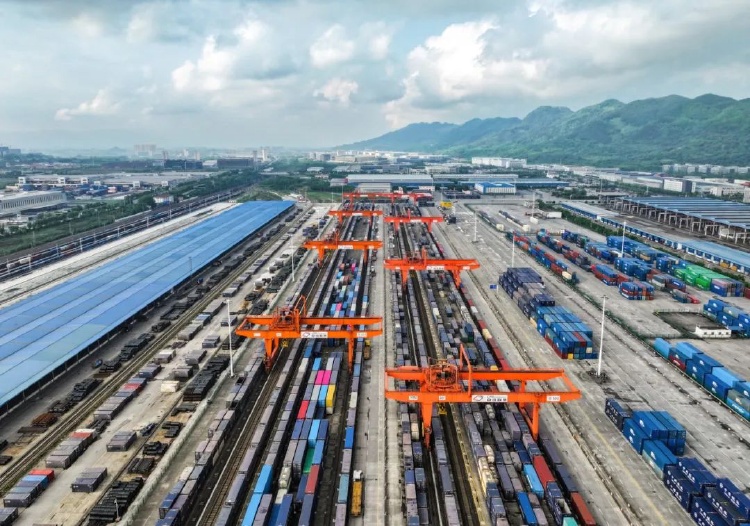 Bridging News
Bridging News
Chongqing Adds 3 New Tax Refund Pilot Sites, Boosting CRE and ILSTC
Chongqing - Southwest China's Chongqing municipality joins China's pilot program for land departure port tax refunds; Tuanjiecun, Yuzui Railway Stations, and Xiaonanya Logistics Center are key sites, as announced at a press conference on December 30.

Tuanjiecun Station serves as a pivotal crossroads for China-Europe freight trains and the ILSTC in Chongqing. (Photo/Long Fan)
This supports major national strategies like the China-Europe Railway Express (CRE), the New International Land-Sea Trade Corridor (ILSTC), and the Belt and Road Initiative (BRI).
"The land departure port tax refund policy allows export enterprises to apply for tax refunds as soon as goods leave designated ports. Previously, Chongqing's inland enterprises had to wait until customs clearance after rail transport. This new policy speeds up the process, reducing wait times and improving capital turnover efficiency for businesses," said He Xiaojun, deputy director of the Chongqing Municipal Finance Bureau.
With this expansion, Chongqing now benefits from the port of departure tax refund policy at four ports, up from just one previously at Guoyuan Port.
Tuanjiecun Railway Station, Western China’s first inland port to open for international trade, serves key western and northern routes. It is the starting point for the China-Europe Railway Express (CRE), the China-Laos-Thailand Railway (ILSTC), and other major rail corridors, all of which are now operating regularly.
Yuzui Railway Station caters to the eastern direction and is a vital junction for three major international logistics corridors: the Yangtze River Golden Waterway, the ILSTC, and the CRE. It also plays a crucial role in promoting the Belt and Road Initiative (BRI) and the integration of the Yangtze River Economic Belt.
The Xiaonanya Railway Logistics Center focuses on southern routes, serving as a multimodal logistics hub for the Yangtze River Economic Belt by combining water and rail transport. Supported by the development of an industrial park, it aims to improve connectivity with Southeast and South Asia.
He further emphasized the expanded coverage of these ports, which are now connected to key national routes. The northern and western routes include Inner Mongolia’s Erenhot Port, Manzhouli Port, Xinjiang’s Alashankou Railway Port, and Horgos Railway Port. The southern route links to Guangxi’s Beibu Gulf Port, Guangdong’s Zhanjiang Port, Shenzhen Port, Nansha Port, and Yunnan’s Mohan Railway Port. The eastern route connects to Ningbo Zhoushan Port in Zhejiang Province.
Currently, Chongqing’s logistics network via the ILSTC spans 18 provinces, 73 cities, and 156 stations in China, reaching 126 countries and regions and connecting to 548 ports. The CRE network operates 51 lines, covering 116 cities across Eurasia, with ongoing expansion.
"As of November this year, Chongqing has issued over 150 million yuan (USD 20.6 million) in tax refunds for ports of departure, improving capital turnover and utilization for export enterprises," said Zhang Xuesong, chief accountant at the Chongqing Municipal Taxation Bureau.
Zhang also highlighted the case of Chongqing Wugu General Equipment Co., Ltd., which shipped micro-tillage machines via the CRE on December 2. After completing the transfer procedures, the company applied for a tax refund on December 4 and received it the next day—about a week earlier than usual. This marks the first land port tax refund in Chongqing, extending the policy from waterway to rail transport.
 Related Stories
Related Stories